Occupancy Sensor Market Size
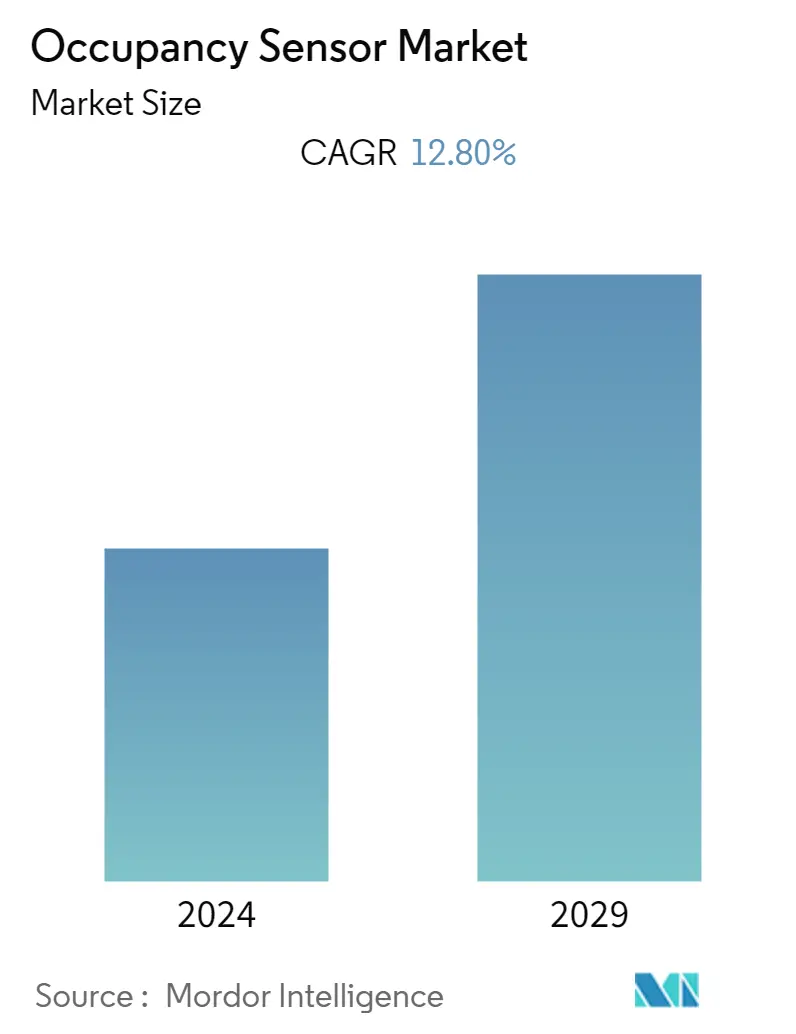
| Study Period | 2019 - 2029 |
| Base Year For Estimation | 2023 |
| CAGR | 12.80 % |
| Fastest Growing Market | Asia Pacific |
| Largest Market | North America |
| Market Concentration | Low |
Major Players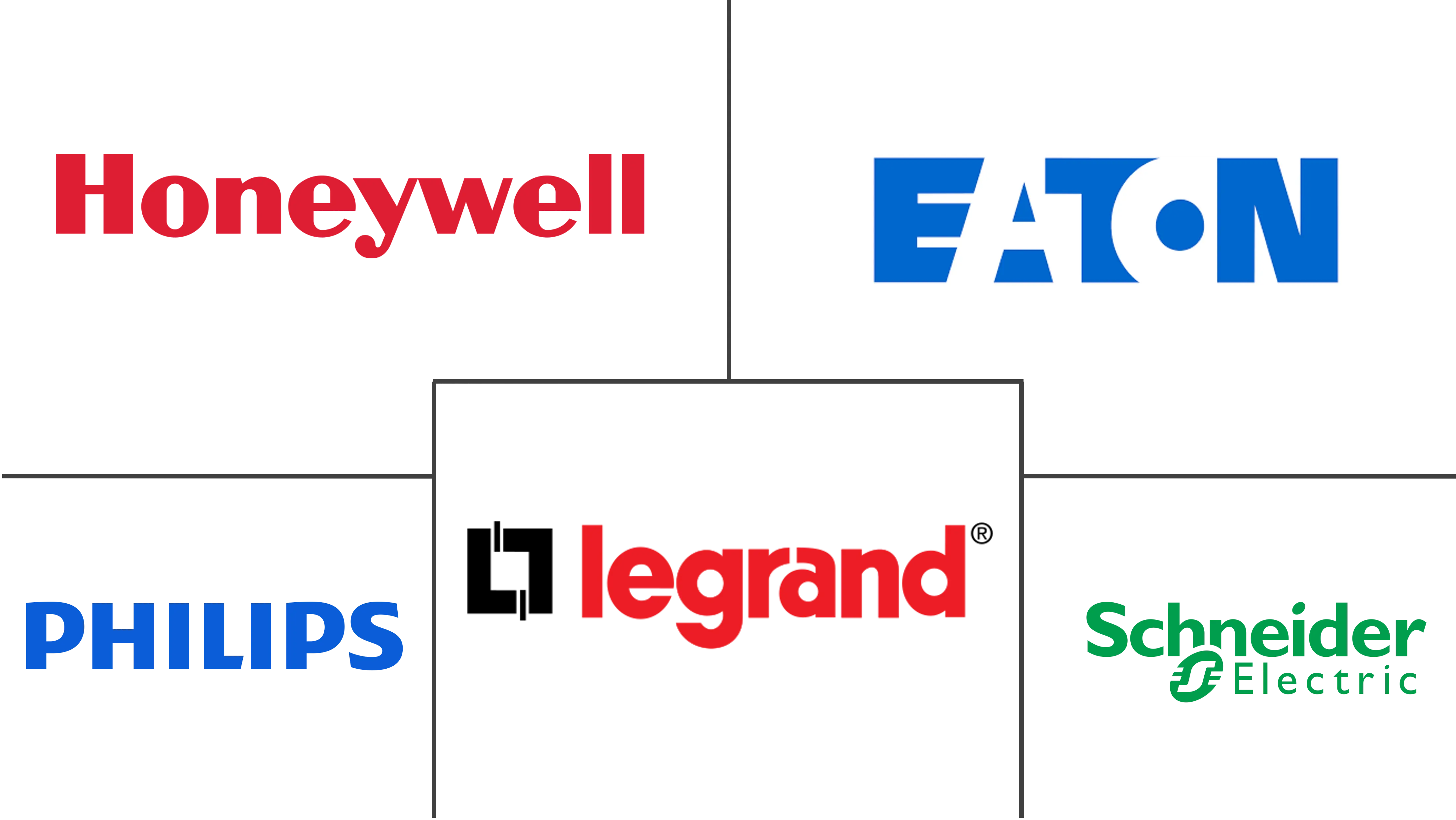
*Disclaimer: Major Players sorted in no particular order |
Need a report that reflects how COVID-19 has impacted this market and its growth?
Occupancy Sensor Market Analysis
The Occupancy Sensor Market registered a CAGR of 12.8% over the forecast period. Sensor-laden lighting systems now have industry acceptance for data-driven applications beyond lighting. In the coming years, OEMs (original equipment manufacturers) may integrate sensors in luminaires to create smart luminaires that can be an integral part of a connected lighting system. Thus, this may drive the market in the future.
- The global occupancy sensor market is expanding rapidly and will continue to expand in the near future. An occupancy sensor is an indoor motion detector that detects the presence of a person in order to operate lights, temperature, or ventilation systems automatically. It turns off lights in empty areas, lowering energy expenses by reducing energy waste.
- Furthermore, as scheduling becomes difficult with occupancy sensors, these are ideal for tasks requiring micro-control. Occupancy sensors are generally used for security purposes, such as preventing damage, burglary, and stealing. These are also utilized to give automatic control, conform with construction requirements, and conserve energy.
- The rising demand for energy-efficient devices is expected to drive the market. Occupancy sensors play a vital role in reducing energy consumption. This is achieved through the sensors, which shut down devices and other equipment on the basis of occupancy. These sensors help in reducing light pollution, and they can be used for indoor and outdoor spaces.
- The demand for passive infrared is expected to continue in the future due to the low cost, demand for energy-efficient devices, and less power requirement. It has a range of applications, such as lighting, spectrometers, gas and fire detection systems, etc. Some of the major benefits of passive infrared sensors are accurate movement detection, reliable triggering, and cost efficiency.
- Despite significant advertising, occupancy sensors are less developed than other lighting technologies, such as motion sensors and vacancy sensors. It is hampered by the difficulty of precisely forecasting the occupant's occupancy. An occupancy sensor's performance is affected by user occupancy, lighting control patterns, and sensor selection. Furthermore, it is regarded as expensive, and there is little awareness of the cost-related benefits of occupancy sensors. This is a barrier to the occupancy sensor market since it has an impact on penetration rates in developing and undeveloped economies.
- During the outbreak of COVID-19, the market witnessed a halt in production and disruption across the supply chain, leading to weakened growth of industrial output and the decline of the occupancy sensor output across significant manufacturing hubs. Manufacturing is anticipated to reach pre-COVID levels over the forecast period as construction of new homes and buildings picks pace.
- The pandemic affected the construction industry, which led to a slump in demand for occupancy sensors, as the newly constructed buildings in the residential and commercial sectors are primary areas of opportunity that support the market's growth. Owing to the restrictions put in place by the governments, all construction activities and most business activities across multiple countries have been affected.
Occupancy Sensor Market Trends
This section covers the major market trends shaping the Occupancy Sensor Market according to our research experts:
Smart City to Increase the Growth of the Occupancy Sensor Market
- The trend of urbanization is growing worldwide, and according to the United Nations Department of Economic and Social Affairs, 60% of the population will be living in cities by 2050. With more people shifting to urban areas, cities across the world will be on a trend to develop smart cities, which may enhance the growth of the market.
- A smart city can create an efficient and smart service delivery platform for public and municipal workers by installing sensors in the city to create platforms that allow the sharing of information. The platform can have a common data warehouse where different sensor systems store their information. A truly smart parking system should be not only aware of the occupancy status of each parking space but also be able to guide the user to it.
- Traffic congestion caused by vehicles is an alarming problem on a global scale, and it has been growing exponentially. Occupancy sensors, like IoT sensors and ultrasonic sensors, play a major role with the help of edge computing, where traffic patterns may help in managing traffic problems very efficiently.
- Santander, the Spanish city, is embedded with more than 12,000 sensors that measure everything from the amount of trash in containers to the number of parking spaces available to the size of crowds. Los Angeles implemented a smart traffic solution to control traffic flow. Road-surface sensors and closed-circuit television cameras send real-time updates about the traffic flow to a central traffic management platform.
- A vision-based occupancy sensing system with real-time data capture and analysis offers major advantages over PIR and video systems. Thus, this may help the smart city development in the growing occupancy sensor market due to its computing model.
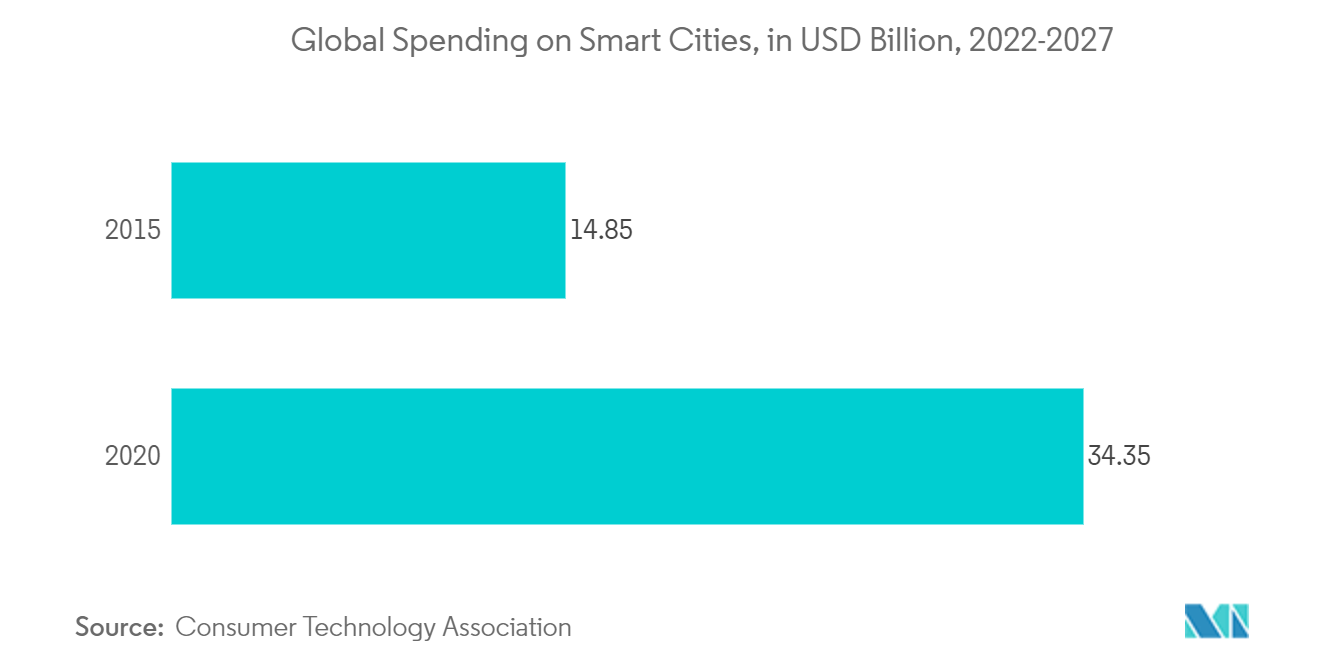
North America to Account for a Significant Market Share
- North America has a higher demand for occupancy sensors for commercial and residential buildings than other regions. This is due to the region's well-organized and regulated value chain for the occupancy sensors industry. This streamlines the ordering and installation procedure. New product advancements and alliances formed by various manufacturers have assisted the North American occupancy sensor market in gaining and maintaining the lead till 2025.
- Additionally, the demand in North America is mainly driven by a higher focus on innovations and advancements in occupancy sensors, such as image processing occupancy sensors (IPOS), intelligent occupancy sensors (IOS), and micro-phonics.
- The largest industry for occupancy sensors is the residential and commercial building industry due to massive growth in the construction sector in this region. Technology has a major role to play in this sector due to its cost-effective matrix.
- The United States is leading the market, owing to the developments in various sectors and the increase in the rise of wireless network infrastructure. Similarly, the growing demand for HVAC systems in the US region is anticipated to play a crucial role in this market.
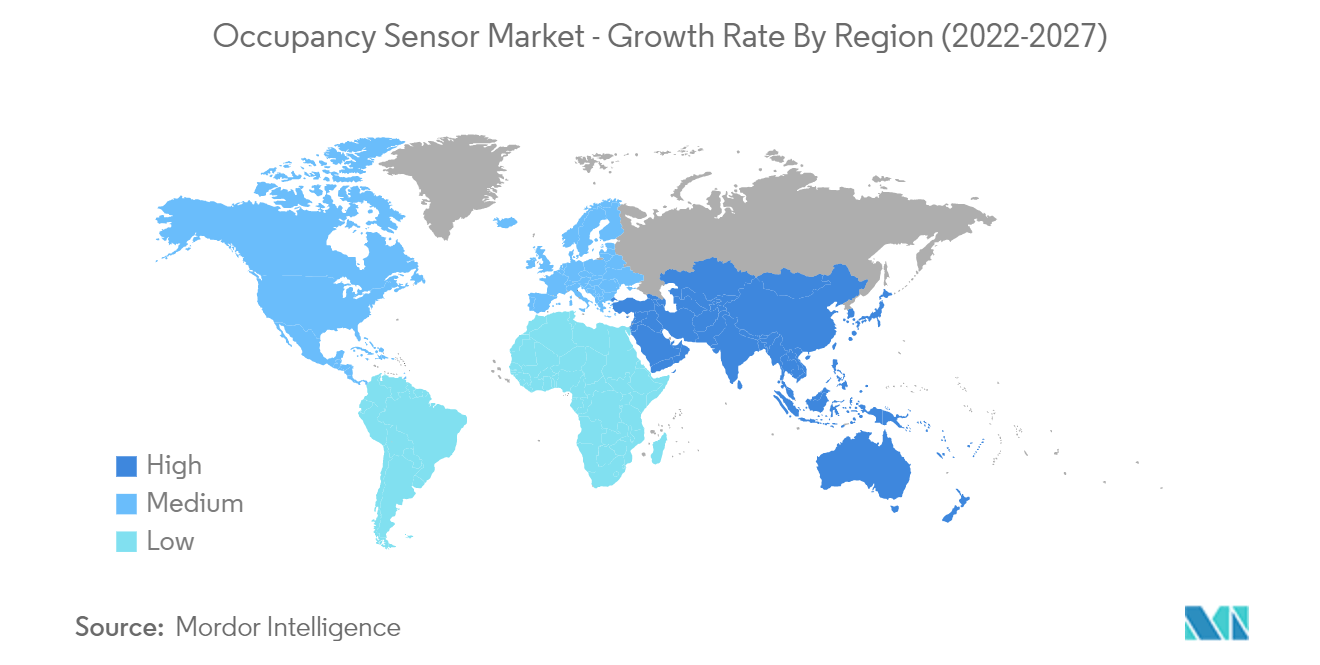
Occupancy Sensor Industry Overview
The Occupancy Sensor Market is significantly fragmented, and the majority of the players functioning in the market are taking steps to raise their market footprint by concentrating on product diversification. The players are focusing on strengthening their product portfolio with the adoption of several strategies, including new product developments, partnerships, mergers, acquisitions, etc., to gain a competitive edge over other players. Key players in the market studied are Honeywell International, Eaton Corporation, and Legrand Inc.
- December 2021 - Aqara announced plans to market its next-generation occupancy sensor, the Aqara Human Presence Sensor FP1. This sensor can detect humans with significantly greater accuracy than a normal PIR (Passive Infrared) sensor, which relies on sensing infrared light emitted by objects in its range of vision. The homeowner is provided a more precise picture of occupancy by using 60GHz millimeter wave technology.
- October 2021 - Wozart, an India-based Smart Home tech business, introduced its latest product designed to connect with Apple HomeKit. The Sense Pro multi-sensor is designed to perform similarly to an occupancy sensor while also providing a number of other features. Thermal imaging focuses on the heat emitted by inhabitants in the room rather than motion, so you can sit motionlessly and still be recognized as being in the room.
Occupancy Sensor Market Leaders
Honeywell International
Eaton Corporation
Legrand Inc.
Schneider Electric
Philips Ltd
*Disclaimer: Major Players sorted in no particular order
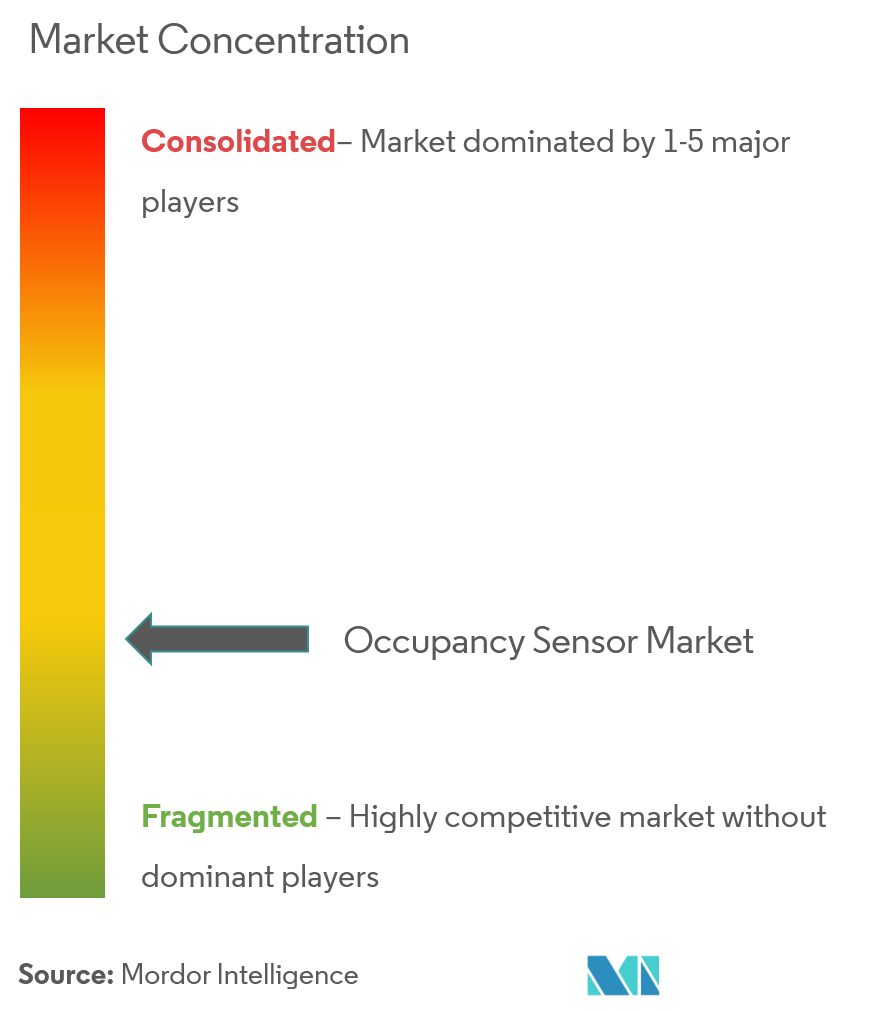
Occupancy Sensor Market News
- June 2022 - Butlr launched as an occupancy-sensing platform that captures the presence and movement of individuals within a space in real-time, stating that the data gathered by the platform can be utilized to revolutionize the workplace. Butlr's platform's spatial insights, occupancy, and activity analytics may be utilized to make data-driven real estate and design decisions, as well as to improve the tenant experience.
- April 2022 - Lumentum Holdings Inc. and Ambarella Inc. have launched a new collaborative reference design for smart building applications that integrates edge artificial intelligence (AI) with privacy. This combination enables the deployment of small AIoT sensors with local processing throughout buildings for applications such as occupancy sensor systems, intelligent space management, and smart retail.
Occupancy Sensor Market Report - Table of Contents
1. INTRODUCTION
1.1 Study Assumptions and Market Definition
1.2 Scope of the Study
2. RESEARCH METHODOLOGY
3. EXECUTIVE SUMMARY
4. MARKET DYNAMICS
4.1 Market Overview
4.2 Introduction to Market Drivers and Restraints
4.3 Market Drivers
4.3.1 Rising Demand for Energy-efficient Devices
4.3.2 Demand for Passive Infrared Due to Low Cost and High Energy Efficiency
4.4 Market Restraints
4.4.1 False Triggering of Switch and Inconsistency Issues Associated with Wireless Network Systems
4.5 Value Chain Analysis
4.6 Industry Attractiveness - Porter's Five Forces Analysis
4.6.1 Threat of New Entrants
4.6.2 Bargaining Power of Buyers
4.6.3 Bargaining Power of Suppliers
4.6.4 Threat of Substitute Products
4.6.5 Intensity of Competitive Rivalry
5. TECHNOLOGY SNAPSHOT
6. MARKET SEGMENTATION
6.1 By Network Type
6.1.1 Wired
6.1.2 Wireless
6.2 By Technology
6.2.1 Ultrasonic
6.2.2 Passive Infrared
6.2.3 Microwave
6.3 By Building Type
6.3.1 Residential
6.3.2 Commercial
6.4 By Application
6.4.1 Lighting Control
6.4.2 HVAC
6.4.3 Security and Surveillance
6.4.4 Other Applications
6.5 By Geography
6.5.1 North America
6.5.1.1 United States
6.5.1.2 Canada
6.5.2 Europe
6.5.2.1 United Kingdom
6.5.2.2 France
6.5.2.3 Germany
6.5.2.4 Italy
6.5.2.5 Rest of Europe
6.5.3 Asia Pacific
6.5.3.1 China
6.5.3.2 Japan
6.5.3.3 South Korea
6.5.3.4 Australia
6.5.3.5 Rest of Asia Pacific
6.5.4 Latin America
6.5.4.1 Mexico
6.5.4.2 Rest of Latin America
6.5.5 Middle East and Africa
7. COMPETITIVE LANDSCAPE
7.1 Company Profiles
7.1.1 Honeywell International
7.1.2 Eaton Corporation
7.1.3 Schneider Electric
7.1.4 Legrand Inc.
7.1.5 Leviton Electronics (Dongguan) Co. Ltd
7.1.6 Philips Ltd
7.1.7 Hubbell Building Automation Inc.
7.1.8 ohnson Controls GmbH
7.1.9 Pammvi Group
7.1.10 Lutron Electronics, Inc.
7.1.11 General Electric
7.1.12 Texas Instruments Incorporated
- *List Not Exhaustive
8. INVESTMENT ANALYSIS
9. FUTURE OF THE MARKET
Occupancy Sensor Industry Segmentation
The scope of the report covers the segments such as network type (Wired and Wireless), technology (Ultrasonic, Passive Infrared, and Microwave), building type (residential and Commercial), and application (Lighting Control, HVAC, and Security and Surveillance), and geography. An occupancy sensor is used to save energy, comply with building codes, provide automatic control, and various other such applications. One of the most widely used technologies among the occupancy sensors is passive infrared, which detects occupancy within a specific field and activates lighting, and is extremely useful in small spaces.
Moreover, the advent of advanced occupancy sensors, such as micro-phonics, intelligent occupancy sensors, image processing occupancy sensors, and the new vision-based intelligent occupancy sensor, for HVAC systems is fueling the growth of the occupancy sensor market.
| By Network Type | |
| Wired | |
| Wireless |
| By Technology | |
| Ultrasonic | |
| Passive Infrared | |
| Microwave |
| By Building Type | |
| Residential | |
| Commercial |
| By Application | |
| Lighting Control | |
| HVAC | |
| Security and Surveillance | |
| Other Applications |
| By Geography | |||||||
| |||||||
| |||||||
| |||||||
| |||||||
| Middle East and Africa |
Occupancy Sensor Market Research FAQs
What is the current Occupancy Sensor Market size?
The Occupancy Sensor Market is projected to register a CAGR of 12.80% during the forecast period (2024-2029)
Who are the key players in Occupancy Sensor Market?
Honeywell International, Eaton Corporation, Legrand Inc., Schneider Electric and Philips Ltd are the major companies operating in the Occupancy Sensor Market.
Which is the fastest growing region in Occupancy Sensor Market?
Asia Pacific is estimated to grow at the highest CAGR over the forecast period (2024-2029).
Which region has the biggest share in Occupancy Sensor Market?
In 2024, the North America accounts for the largest market share in Occupancy Sensor Market.
What years does this Occupancy Sensor Market cover?
The report covers the Occupancy Sensor Market historical market size for years: 2019, 2020, 2021, 2022 and 2023. The report also forecasts the Occupancy Sensor Market size for years: 2024, 2025, 2026, 2027, 2028 and 2029.
Occupancy Sensor Industry Report
Statistics for the 2024 Occupancy Sensor market share, size and revenue growth rate, created by Mordor Intelligence™ Industry Reports. Occupancy Sensor analysis includes a market forecast outlook 2029 and historical overview. Get a sample of this industry analysis as a free report PDF download.
